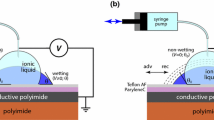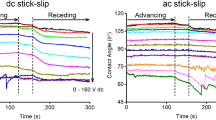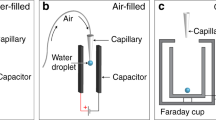Abstract
Electrowetting (EW) involves the application of an electric potential across a solid–liquid (SL) interface, which modifies the wetting properties of that interface by reducing the SL surface energy and induces a contact-angle change without altering either the bulk liquid or solid properties. Reversible contact angles are achieved at low potentials, while the application of high potentials results in contact-angle saturation and system instabilities. In the present work, an EW system consisting of a substrate (plate or rod) coated with a thin Au underlayer, a dielectric (parylene) layer of various thickness and a 100-nm layer of fluoropolymer (Teflon AF1600) is studied both theoretically and experimentally. A theoretical consideration of the EW effect, taking into account the detailed structure of the electrical double layer, and a model for the saturation of the contact angle observed at high applied potentials are presented. The theoretical treatment presented here confirms that the EW effect is, in the most part, due to polarization of the dielectric, as opposed to purely a rearrangement of the double layer, and explains why no dependence of the EW effect on the electrolyte concentration has been observed. The theory is only applicable over a limited potential range, and we have developed a model that predicts the potential at which this limit occurs. This is the potential at which the SL surface energy becomes zero. The limiting potential is dependent only on the bulk liquid and solid properties and is thus fixed for a given system. Experimentally, the limiting potential corresponds to the onset of contact-angle saturation, although variations in the exact angle of saturation are not uncommon due to the kinetic effects involved in a real system as opposed to a strict thermodynamic analysis. The model predicts that for an EW device in which an aqueous droplet can be forced to completely wet a hydrophobic surface, a surface with basically the same surface energy as the liquid is required.
Similar content being viewed by others
Author information
Authors and Affiliations
Additional information
Received: 2 January 1998 Accepted: 21 March 1998
Rights and permissions
About this article
Cite this article
Peykov, V., Quinn, A. & Ralston, J. Electrowetting: a model for contact-angle saturation. Colloid Polym Sci 278, 789–793 (2000). https://doi.org/10.1007/s003960000333
Issue Date:
DOI: https://doi.org/10.1007/s003960000333




